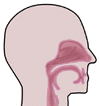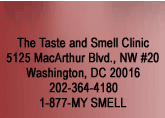  |
||||||||||||||||||||||||||||||||||||||||||||
 |
December 2004 Severe Taste Loss (Hypogeusia) Is a Predictive Factor in Treatment of Burning Mouth Syndrome (BMS) Burning mouth syndrome is a complaint most commonly observed in post menopausal women but present to some extent in both men and women of all ages. Its etiology has been obscured by the lack of any obvious oral cavity pathology and has been commonly regarded as some type of psychological entity related to stress, hormonal lack or psychiatric phenomena. Treatment of this disorder has varied because of the lack of etiological definition and because whatever method has been devised has usually been ineffective. We have recognized that the primary mechanistic defect of this syndrome lies not in the oral cavity but in the brain (see What’s New, September 2004) related mainly to a decrease in a brain neurotransmitter called gamma-aminobutyric acid (GABA) located in specific brain regions. Since GABA is the major inhibitory neurotransmitter within the brain decreased levels of brain GABA release inhibitory impulses in these specific brain regions which are appreciated in some patients as uncontrolled oral burning. Patients with BMS are usually first evaluated by dentists who are understandably confused since they are unable to relate the burning to any oral pathology. This has not inhibited some dentists from attempting to treat this symptom by replacing all dental fillings with some different material or even from extracting multiple teeth. These destructive processes are uniformly unsuccessful in controlling BMS. While we have previously demonstrated that treatment with GABAergic agents are successful in controlling BMS in about 70% of these patients identification of specific patients who might benefit from this therapy PRIOR TO TREATMENT has not been well defined. We have previously discovered that lower than normal levels of salivary magnesium is one method to identify prospective patients who might benefit from treatment with GABAergic agents. We now add another set of parameters to these measurements to select prospective patients who might benefit from treatment with GABAergic agents (FASEB J, 2005, in press). These new parameters relate to the degree of taste impairment (hypogeusia) present among patients with BMS; those with the more extreme hypogeusia for salt and sweet tastants measured BEFORE TREATMENT are those who are more amenable to successful treatment with GABAergic agents. Patients with BMS, as a group, exhibit hypoguesia. To determine hypogeusia one test involves the ability to DETECT different tastes. For the DETECTION TEST one drop of four common tastants (salt, sweet, sour and bitter) is placed on the patient’s tongue and they are forced to determine whether the drop of tastant is different from two drops of similarly placed water. The result of this test is called a detection threshold (DT). Patients with BMS as a class exhibit higher DTs than do normal subjects (Table I) and among patients with BMS those with the highest DTs (poorest ability to detect) are the ones who are most amenable to successful treatment with GABAergic agents (Table II).
( ), Subject number
These results indicate that patients with BMS exhibit impaired ability to detect all tastants compared to normals and that this impairment is significant for salt (NaCl) and bitter (urea) tastants. If we now compare DTs for salt and sweet tastants BEFORE TREATMENT in patients who improved AFTER GABAergic TREATMENT with those who did not we find that prior to treatment patients who improved with GABAergic agents had more severe hypogeusia (higher or more impaired DTs) for salt and sweet tastants than those who did not improve.
( ), Subject number
These results indicate that patients before treatment who were subsequently successfully treated with GABAergic agents had more impaired ability to detect salt and sweet tastants than did patients who were not successfully treated (i.e. their symptoms of burning were not diminished). These results indicate that successful treatment with GABAergic agents can be predicted based upon the degree of hypogeusia present among patients prior to treatment; the greater the hypogeusia, the greater the probability that they will respond to GABAergic therapy. Home
| The Clinic | Diagnosis
| Treatment | FAQ
| Press
|
|||||||||||||||||||||||||||||||||||||||||||